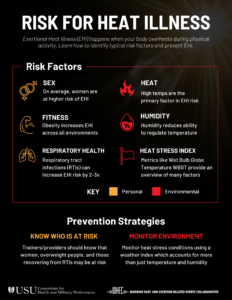Why is this study important?
Exertional heat illness (EHI) is a threat whenever people exercise for long periods of time in the heat. Risks for EHI include intrinsic factors, such as fitness, medical history, and demographics. Extrinsic factors include hot weather conditions.
This study leveraged a large standardized database from US defense administrative records. The study looked at first-year US Army enlistees – a healthy and relatively homogenous population, who are at elevated risk for EHI. By examining a large sample, the study was able to learn about different types of risks over a prolonged time-period.
How did the study go about this?
The study used US defense administrative records from a variety of sources: personnel records, fitness/body composition records, and electronic health records.
The authors also examined the impact of local weather trends, by using a gridded climate data source [1,2]. This provided daily estimates of heat stress, which were able to be triangulated with soldiers’ geographical locations.
What did the study find?
Key findings highlighted the role of sex, obesity, respiratory tract infections, and climate index in developing EHI. Women and overweight/obese soldiers tended to be at elevated risk. Surprisingly, respiratory tract infections increased risk of EHI by 2-3 fold as well.
Findings also highlighted the role of heat stress indexes in preventing EHI. Traditionally, the wet bulb globe temperature (WBGT) has been used to plan physical activity outdoors and to set activity restrictions when heat stress is too high.3 The findings highlighted the potential role for a new index, called the Universal Thermal Climate Index (UTCI) [4].
What are the key take-home points?
When planning physical activity in the heat, trainers and providers should keep in mind that women or overweight/obese individuals may be at elevated risk for EHI. People who are recovering from respiratory tract infections may be at elevated risk too, and therefore should be afforded adequate time to recover.
It is always important to monitor heat stress conditions, ideally using a weather index which accounts for more than just temperature and humidity. Traditionally, the WBGT has filled this role. More observational research into other indexes is warranted to potentially improve on the WBGT’s predictive accuracy and role in setting activity modifications [5].

Article authors and affiliations:
Josh B Kazman (1,2,3,4) D Alan Nelson (5), Anwar E Ahmed (4), Patricia A Deuster (1)
Francis G O’Connor,1 James D Mancuso,4 Stephen A Lewandowski4
- Consortium for Health and Military Performance, Department of Military and Emergency Medicine, Uniformed Services University of the Health Sciences F Edward Hebert School of Medicine, Bethesda, Maryland, USA
- 2. Henry M Jackson Foundation for the Advancement of Military Medicine Inc, Rockville, Maryland, USA
- Department of Clinical Investigation, Womack Army Medical Center, Fort Liberty, NC, USA
- Department of Preventive Medicine and Biostatistics, F. Edward Hébert School of Medicine, Uniformed Services University of the Health Sciences, Bethesda, Maryland, USASchool of Health Professions, University of Texas Health Science Center at San Antonio, San Antonio, Texas, USA
References
- Di Napoli C, Barnard C, Prudhomme C, et al. ERA5‐HEAT: A global gridded historical dataset of human thermal comfort indices from climate reanalysis. Geosci Data 2021;8:2–10.
- Hersbach H, Bell B, Berrisford P, et al. The ERA5 global reanalysis. Quart J Royal Meteoro Soc 2020;146:1999–2049.
- Budd GM. Wet-bulb globe temperature (WBGT)–its history and its limitations. J Sci Med Sport 2008;11:20–32.
- Jendritzky G, de Dear R, Havenith G. UTCI–why another thermal index? Int J Biometeorol 2012;56:421–8.
- Grundstein A, Vanos J. There is no “Swiss Army Knife” of thermal indices: the importance of considering “why?” and “for whom?” when modelling heat stress in sport. Br J Sports Med 2021;55:822–4.